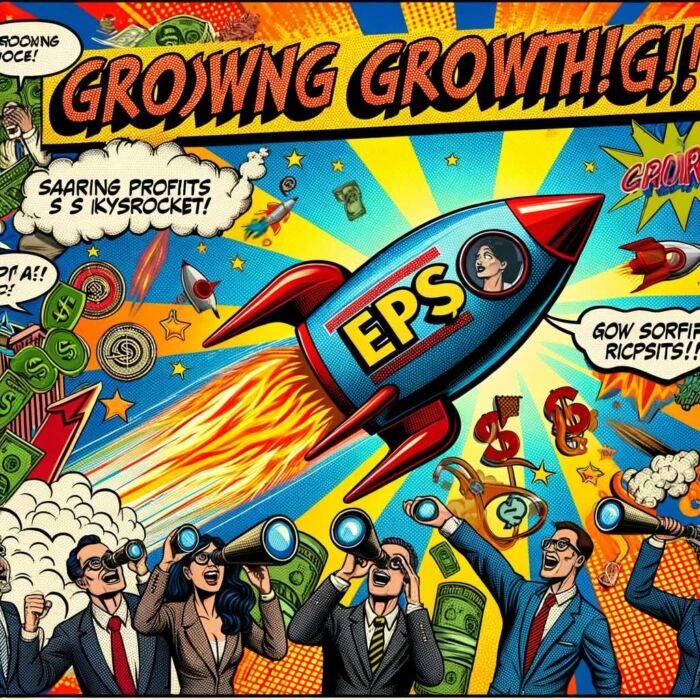Value investing is a strategy that has been used by investors for decades to find undervalued companies and profit from their potential growth. While value investing involves a comprehensive analysis of various factors, there are certain key metrics that investors look at when evaluating stocks. In this article, we will discuss some of the key metrics that investors use in value investing.
Value Investing: Key Metrics
Different investors may use different key metrics in value investing depending on their investment strategies, objectives, and risk tolerance. Some investors may focus on fundamental analysis and use metrics related to a company’s financial health, while others may take a more quantitative approach and use metrics related to market trends and momentum.
For example, value investors who focus on fundamental analysis may use metrics such as P/E ratio, P/B ratio, dividend yield, and earnings growth rate to evaluate a company’s financial health and growth potential. On the other hand, investors who use a quantitative approach may use metrics such as price momentum, relative strength, and moving averages to identify stocks with upward price trends.

P/E Ratio
- Price-to-Earnings Ratio (P/E Ratio): The price-to-earnings (P/E) ratio is a popular metric used to evaluate a company’s stock price in relation to its earnings. It is calculated by dividing the current stock price by the earnings per share (EPS) of the company. A low P/E ratio suggests that a stock is undervalued and has potential for growth.
However, a low P/E ratio could also mean that the company is facing financial difficulties or has a poor outlook. A high P/E ratio, on the other hand, suggests that the market has high expectations for the company’s future earnings.
source: One Minute Economics on YouTube

P/B Ratio
- Price-to-Book Ratio (P/B Ratio): The price-to-book (P/B) ratio is a metric used to evaluate a company’s stock price in relation to its book value. It is calculated by dividing the current stock price by the book value per share of the company. A low P/B ratio suggests that a stock is undervalued and has potential for growth.
Hence, a low P/B ratio could also mean that the company is facing financial difficulties or has a poor outlook. A high P/B ratio, on the other hand, suggests that the market has high expectations for the company’s future earnings.
source: The Organic Chemistry Tutor on YouTube

Dividend Yield
- Dividend Yield: The dividend yield is a metric used to evaluate a company’s dividend payments in relation to its stock price. It is calculated by dividing the annual dividend payment by the current stock price. A high dividend yield suggests that a stock is undervalued and has potential for growth.
A high dividend yield could also mean that the company is facing financial difficulties or has a poor outlook. Investors should also consider the sustainability of the dividend payments and the company’s ability to maintain or increase them in the future.
source: The Finance Storyteller on YouTube

Free Cash Flow
- Free Cash Flow: Free cash flow is a metric used to evaluate a company’s ability to generate cash after accounting for capital expenditures. It is calculated by subtracting capital expenditures from operating cash flow. A positive free cash flow suggests that a company has the ability to invest in future growth and return value to shareholders through dividends or share buybacks.
However, negative free cash flow could mean that the company is not generating enough cash to cover its expenses or invest in future growth. Investors should also consider the company’s debt levels and its ability to manage debt.
source: The Finance Storyteller on YouTube

Return On Equity
- Return on Equity (ROE): Return on Equity (ROE) is a metric used to evaluate a company’s profitability in relation to the amount of equity invested by shareholders. It is calculated by dividing net income by shareholder equity. A high ROE suggests that a company is generating a significant return on the equity invested by shareholders.
Consequently, a high ROE could also be the result of excessive leverage or financial risk, which could be a concern for investors. Therefore, investors should also consider the company’s debt levels and financial health when evaluating ROE.

P/S Ratio
- Price-to-Sales Ratio (P/S Ratio): The price-to-sales (P/S) ratio is a metric used to evaluate a company’s stock price in relation to its sales revenue. It is calculated by dividing the current stock price by the annual sales revenue per share of the company. A low P/S ratio suggests that a stock is undervalued and has potential for growth.
Furthermore, a low P/S ratio could also mean that the company is facing financial difficulties or has a poor outlook. A high P/S ratio, on the other hand, suggests that the market has high expectations for the company’s future sales revenue.
source: WallStreetMojo on YouTube

D/E Ratio
- Debt-to-Equity Ratio (D/E Ratio): The debt-to-equity ratio is a metric used to evaluate a company’s financial leverage. It is calculated by dividing total liabilities by shareholder equity. A low debt-to-equity ratio suggests that a company is using less debt and is therefore less risky.
A low debt-to-equity ratio could also mean that the company is not taking advantage of opportunities for growth. A high debt-to-equity ratio, on the other hand, suggests that the company is using more debt to finance its operations, which could be a concern for investors.
source: Rule #1 on YouTube

EPS Growth
- Earnings per Share Growth (EPS Growth): Earnings per Share Growth (EPS Growth) is a metric used to evaluate a company’s growth potential. It is calculated by comparing the current EPS to the EPS of the previous period. A high EPS growth rate suggests that a company has potential for growth and could increase its earnings in the future.
However, investors should also consider the sustainability of the EPS growth rate and the company’s ability to maintain or increase it in the future.
source: Everything Money on YouTube

P/CF Ratio
- Price-to-Cash Flow Ratio (P/CF Ratio): The Price-to-Cash Flow (P/CF) ratio is a metric used to evaluate a company’s stock price in relation to its cash flow. It is calculated by dividing the current stock price by the cash flow per share of the company. A low P/CF ratio suggests that a stock is undervalued and has potential for growth.
Hence, a low P/CF ratio could also mean that the company is facing financial difficulties or has a poor outlook. A high P/CF ratio, on the other hand, suggests that the market has high expectations for the company’s future cash flow.
source: Teach Me Finance on YouTube

P/OCF Ratio
- Price-to-Operating Cash Flow Ratio (P/OCF Ratio): The Price-to-Operating Cash Flow (P/OCF) ratio is a metric used to evaluate a company’s stock price in relation to its operating cash flow. It is calculated by dividing the current stock price by the operating cash flow per share of the company. A low P/OCF ratio suggests that a stock is undervalued and has potential for growth.
Moreover, a low P/OCF ratio could also mean that the company is facing financial difficulties or has a poor outlook. A high P/OCF ratio, on the other hand, suggests that the market has high expectations for the company’s future operating cash flow.
source: The Finance Storyteller on YouTube

PEG Ratio
- Price-to-Earnings Growth (PEG): Ratio Price-to-Earnings Growth (PEG) ratio is a metric used to evaluate a company’s stock price in relation to its earnings growth. It is calculated by dividing the P/E ratio by the expected earnings growth rate. A low PEG ratio suggests that a stock is undervalued and has potential for growth.
Consequently, a low PEG ratio could also mean that the company is facing financial difficulties or has a poor outlook for earnings growth. Investors should also consider the sustainability of the earnings growth rate and the company’s competitive advantage.
source: Corporate Finance Institute on YouTube

EV/R Ratio
- Enterprise Value-to-Revenue (EV/R) Ratio: Enterprise Value-to-Revenue (EV/R) ratio is a metric used to evaluate a company’s valuation in relation to its revenue. It is calculated by dividing the enterprise value by the annual revenue of the company. A low EV/R ratio suggests that a stock is undervalued and has potential for growth.
However, a low EV/R ratio could also mean that the company is facing financial difficulties or has a poor outlook for revenue growth. Investors should also consider the company’s debt levels and financial health when evaluating EV/R.

EV/EBITDA Ratio
- Enterprise Value-to-EBITDA (EV/EBITDA): Ratio Enterprise Value-to-EBITDA (EV/EBITDA) ratio is a metric used to evaluate a company’s valuation in relation to its EBITDA. It is calculated by dividing the enterprise value by the EBITDA of the company. A low EV/EBITDA ratio suggests that a stock is undervalued and has potential for growth.
A low EV/EBITDA ratio could also mean that the company is facing financial difficulties or has a poor outlook for EBITDA growth. Investors should also consider the company’s debt levels and financial health when evaluating EV/EBITDA.
source: New Money on YouTube
What Value Metrics Does Warren Buffett Use?
Warren Buffett, widely regarded as one of the most successful value investors in history, has employed a range of key metrics to evaluate stocks over the years. These metrics provide insight into a company’s financial health, growth potential, and market value. In this article, we’ll take a closer look at the key metrics that Warren Buffett has used and how they have helped him identify high-quality investments.
Warren Buffet Key Value Metrics
The first metric that Warren Buffett has often used is the Price-to-Earnings (P/E) ratio. This ratio compares a company’s stock price to its earnings per share and helps investors determine whether a stock is undervalued or overvalued. Buffett has stated that he prefers to buy stocks with a low P/E ratio because they are generally undervalued by the market.
Another important metric that Warren Buffett has used is the Price-to-Book (P/B) ratio. This ratio compares a company’s stock price to its book value per share and helps investors identify undervalued stocks that have a low market price relative to their book value.
Return on Equity (ROE) is another key metric that Buffett has emphasized. This metric measures a company’s profitability by calculating the net income it generates as a percentage of shareholder equity. Buffett has stated that he likes companies with high ROE because they tend to be more efficient at generating profits.
The Debt-to-Equity ratio is yet another metric that Buffett has used to evaluate companies. This ratio measures a company’s leverage by comparing its debt to its equity. Buffett has stated that he prefers companies with low debt-to-equity ratios because they tend to have a lower financial risk and can manage their debt more effectively.
Free Cash Flow (FCF) is a metric that measures the cash generated by a company’s operations after accounting for capital expenditures. Buffett has stated that he likes companies with high FCF because they tend to have more flexibility to invest in growth opportunities or return cash to shareholders through dividends or share buybacks.

Warren Buffet Searches For Economic Moat Opportunities
Moreover, Buffett has emphasized the importance of identifying a company’s economic moat. The economic moat refers to a company’s competitive advantage that allows it to maintain its market position and generate profits over the long term. Buffett has stated that he looks for companies with a strong economic moat because they are more likely to be able to withstand competition and generate sustainable profits.
Warren Buffett’s investment philosophy focuses on identifying high-quality companies that are undervalued by the market and have a strong competitive position in their industry. His use of key metrics such as the P/E ratio, P/B ratio, ROE, Debt-to-Equity ratio, FCF, and economic moat has helped him make informed investment decisions and achieve long-term success. By conducting thorough research and analysis of a company’s financial health and growth potential using these metrics, investors can improve their chances of identifying undervalued investments and generating long-term returns.
source: Talks at Google on YouTube
Frequently Asked Questions About Key Metrics for Value Investing: P/E, P/B, P/S, EV/EBITDA, and More
1. What is the most important metric in value investing?
There isn’t a single “most important” metric, but the P/E ratio is often a starting point. It compares price to earnings and helps investors gauge if a stock is undervalued relative to its profit. However, successful value investors like Warren Buffett combine it with P/B, ROE, and free cash flow for a fuller picture.
2. How does the P/E ratio help identify undervalued stocks?
The Price-to-Earnings (P/E) ratio shows how much investors are willing to pay for each dollar of earnings. A low P/E may indicate undervaluation, but it can also reflect poor growth prospects or financial trouble—context and comparison with peers are key.
3. What does the P/B ratio reveal about a company’s value?
The Price-to-Book (P/B) ratio compares a company’s market price to its book value (assets minus liabilities). A low P/B suggests a stock might be trading below its intrinsic worth, often appealing to deep-value investors seeking a margin of safety.
4. How is the P/S ratio different from P/E?
The Price-to-Sales (P/S) ratio evaluates a company’s price relative to its total revenue rather than earnings. It’s particularly useful for companies with irregular profits or early-stage firms where earnings are minimal but revenue is growing.
5. What does EV/EBITDA tell investors about valuation?
The Enterprise Value-to-EBITDA (EV/EBITDA) ratio helps compare companies regardless of capital structure. It shows how expensive a company is relative to its operating cash flow. Lower values may signal attractive opportunities in comparison to peers.
6. Why is Free Cash Flow so important in valuation?
Free Cash Flow (FCF) measures how much cash remains after capital expenditures. It represents the lifeblood of a company—funding dividends, buybacks, or growth. High and stable FCF signals financial flexibility and operational efficiency.
7. What role does Return on Equity (ROE) play in evaluating a company?
ROE measures how efficiently management uses shareholder capital to generate profits. Consistently high ROE values indicate strong business performance, but investors should ensure it’s not inflated by excessive leverage.
8. How is the Debt-to-Equity ratio used in value investing?
The D/E ratio assesses a firm’s leverage by comparing total debt to shareholders’ equity. Low D/E ratios imply conservative financing and less financial risk, aligning well with the long-term preservation goals of value investors.
9. What does the PEG ratio add beyond P/E?
The Price-to-Earnings-to-Growth (PEG) ratio adjusts the P/E by accounting for expected earnings growth. A PEG under 1 can indicate undervaluation relative to growth potential—ideal for investors balancing value and growth considerations.
10. How does EV/Revenue complement other valuation ratios?
The EV/Revenue (EV/R) ratio compares enterprise value to total sales, offering a top-line perspective on valuation. It’s handy for assessing cyclical or unprofitable firms where EBITDA may be inconsistent.
11. Which metrics does Warren Buffett rely on most?
Buffett focuses on P/E, P/B, ROE, Debt-to-Equity, and Free Cash Flow, emphasizing strong economic moats, steady profitability, and low leverage. He prefers quality companies trading at fair or discounted prices.
12. Should investors rely only on quantitative metrics?
No—quantitative metrics must be paired with qualitative factors such as management quality, competitive advantage, brand strength, and market position. Value investing succeeds when numbers and narrative align to reveal durable long-term value.
Final Thoughts: Key Metrics For Value Investing
In addition to these key metrics, investors should also consider other factors such as the company’s financial strength, stability, and growth potential. They should also consider industry and market trends, the management team and leadership, and any potential risks associated with the company and its operations.
It is important to note that value investing involves a comprehensive analysis of various factors, and investors should not rely solely on quantitative metrics when evaluating stocks. Investors should also consider qualitative factors such as the company’s competitive advantage, brand recognition, and management team.

In conclusion, value investing is a strategy that involves a comprehensive analysis of various factors, including key metrics such as the P/E ratio, P/B ratio, dividend yield, and free cash flow. However, investors should also consider qualitative factors when evaluating stocks, and should conduct thorough research and analysis before making any investment decisions. By understanding and using these key metrics, investors can identify undervalued stocks and potentially profit from their growth potential.
Important Information
Comprehensive Investment Disclaimer:
All content provided on this website (including but not limited to portfolio ideas, fund analyses, investment strategies, commentary on market conditions, and discussions regarding leverage) is strictly for educational, informational, and illustrative purposes only. The information does not constitute financial, investment, tax, accounting, or legal advice. Opinions, strategies, and ideas presented herein represent personal perspectives, are based on independent research and publicly available information, and do not necessarily reflect the views or official positions of any third-party organizations, institutions, or affiliates.
Investing in financial markets inherently carries substantial risks, including but not limited to market volatility, economic uncertainties, geopolitical developments, and liquidity risks. You must be fully aware that there is always the potential for partial or total loss of your principal investment. Additionally, the use of leverage or leveraged financial products significantly increases risk exposure by amplifying both potential gains and potential losses, and thus is not appropriate or advisable for all investors. Using leverage may result in losing more than your initial invested capital, incurring margin calls, experiencing substantial interest costs, or suffering severe financial distress.
Past performance indicators, including historical data, backtesting results, and hypothetical scenarios, should never be viewed as guarantees or reliable predictions of future performance. Any examples provided are purely hypothetical and intended only for illustration purposes. Performance benchmarks, such as market indexes mentioned on this site, are theoretical and are not directly investable. While diligent efforts are made to provide accurate and current information, “Picture Perfect Portfolios” does not warrant, represent, or guarantee the accuracy, completeness, or timeliness of any information provided. Errors, inaccuracies, or outdated information may exist.
Users of this website are strongly encouraged to independently verify all information, conduct comprehensive research and due diligence, and engage with qualified financial, investment, tax, or legal professionals before making any investment or financial decisions. The responsibility for making informed investment decisions rests entirely with the individual. “Picture Perfect Portfolios” explicitly disclaims all liability for any direct, indirect, incidental, special, consequential, or other losses or damages incurred, financial or otherwise, arising out of reliance upon, or use of, any content or information presented on this website.
By accessing, reading, and utilizing the content on this website, you expressly acknowledge, understand, accept, and agree to abide by these terms and conditions. Please consult the full and detailed disclaimer available elsewhere on this website for further clarification and additional important disclosures. Read the complete disclaimer here.





